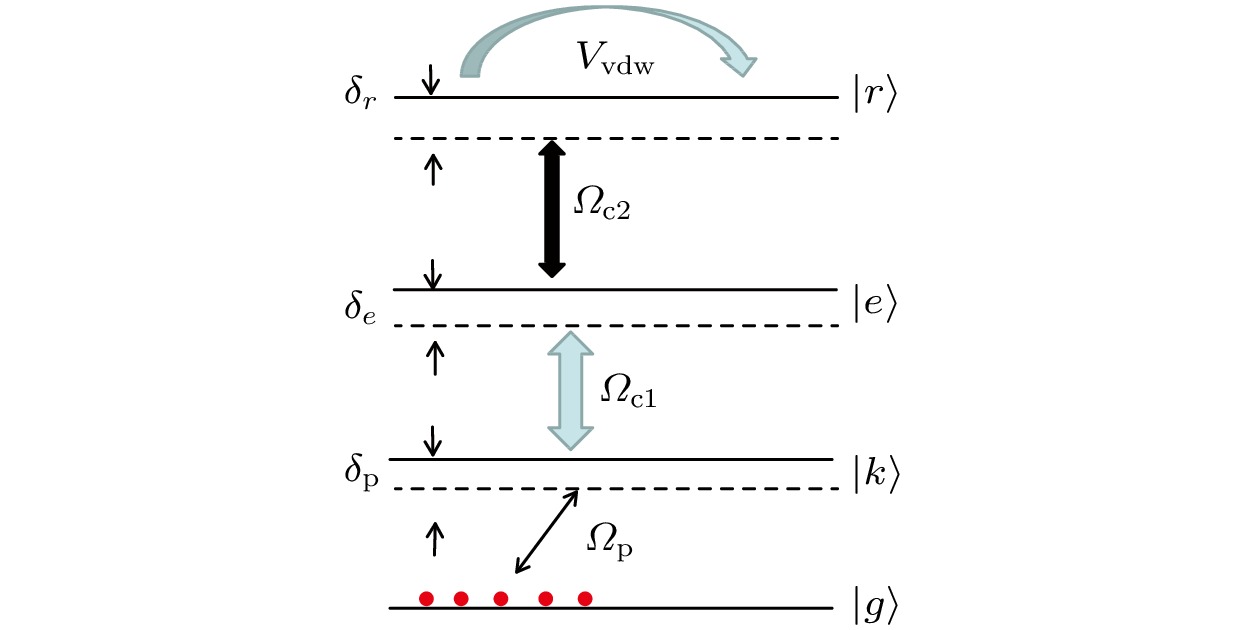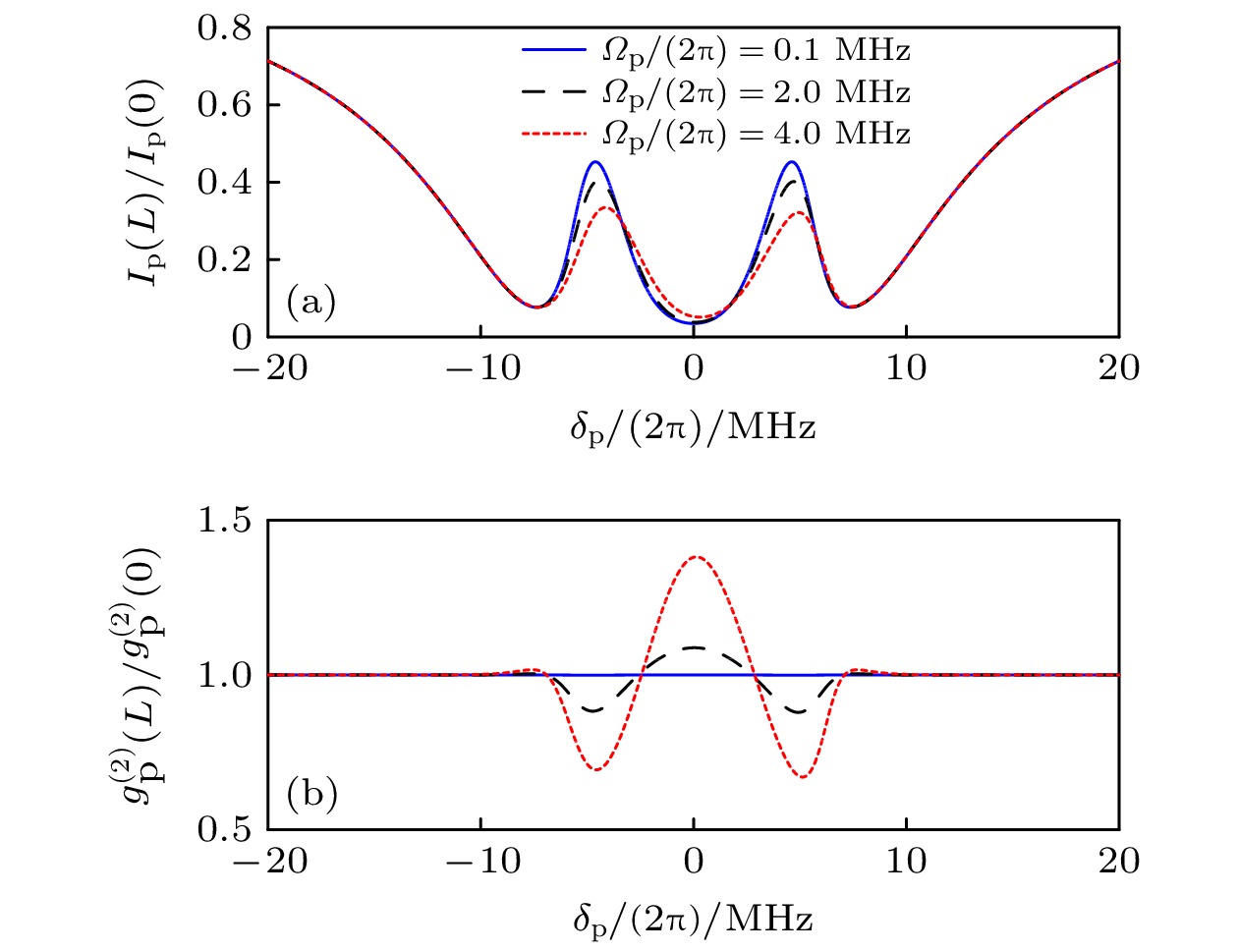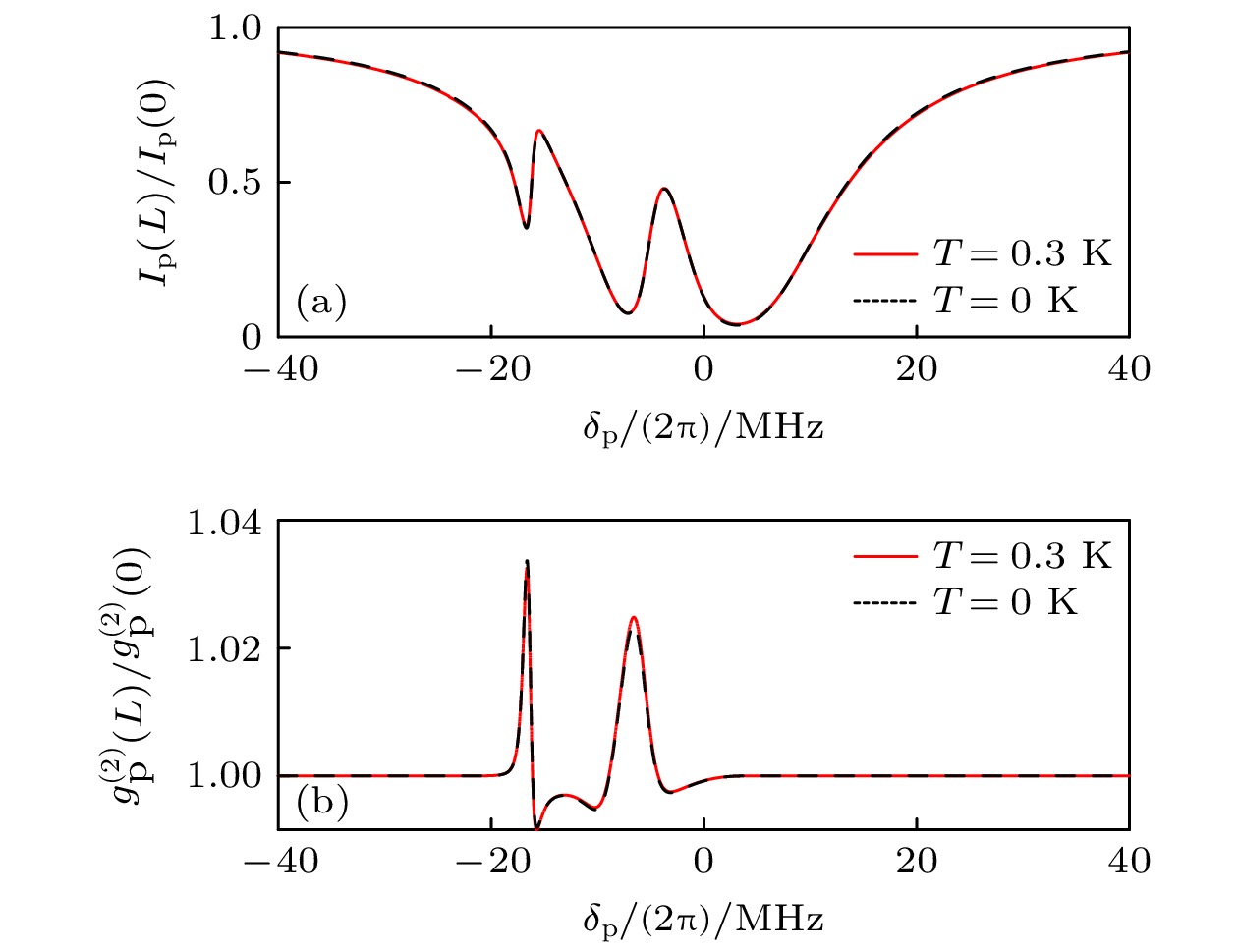-
采用超级原子模型研究了一个巨梯型四能级里德伯原子系统与一个弱光场和两个强控制场的相互作用. 利用蒙特卡罗算法, 通过数值求解海森伯-朗之万方程, 讨论了系统的动力学演化, 研究了偶极-偶极相互作用对探测场透射谱和二阶强度关联函数的影响. 在有限温度下, 利用洛伦兹分布函数代替麦克斯韦分布函数, 得到解析的探测场极化率, 讨论了强场的失谐量对系统出射探测场透射谱对称性质的影响, 最后研究了多普勒效应对探测场透射谱和二阶强度关联函数的影响. 结果表明, 在电磁诱导透明条件下, 透明窗口处出射探测场的透射率随着入射探测场强度的增强而减弱, 而当系统入射探测场强度不变时, 通过改变强场的失谐量可以得到非对称的透射谱. 此外, 当弱探测场和强场的传播方向一致时, 多普勒效应对系统透射谱和二阶强度关联函数的峰值有很小的影响. 当探测场和强场的传播方向不一致时, 多普勒效应对系统透射谱和二阶强度关联函数的影响可以忽略.In this paper, we study the interaction of a giant ladder type four-level Rydberg atomic system with a weak light field and two strong control fields separately. We use the Monte Carlo method to calculate the dynamic evolution of this system and investigate the influence of dipole-dipole interaction on the transmission spectrum and second-order intensity correlation function of the weak probe field. By changing the value of detuning
$\delta_e$ and$\delta_r$ , we can obtain the asymmetric transmission spectrum of the four-level Rydberg atomic system. The influence of Doppler effect on transmission spectrum and second-order intensity correlation function are also studied. By using super atom model, the influences of different incident probe field intensities on the transmission spectrum and the second-order intensity correlation function of probe field are discussed in the Rydberg atomic system. The results show that the transmission spectrum of the four-level Rydberg atomic system is symmetric when the detuning$\delta_e=\delta_r=0$ . We obtain the asymmetric transmission spectrum of the system when the value of detuning$(\delta_e, \delta_r)$ changes from 0 to 43 MHz. In order to evaluate the influence of temperature on the transmission spectrum of the system, the Lorentz distribution function is introduced to calculate the polarizability analytically. And, the influence of temperature on the asymmetric transmission spectrum and the second-order intensity correlation function are discussed at finite temperature separately. The results show that the transmittance of the outgoing probe field at the transparent window decreases with the increase of the intensity of the incident probe light field under the condition of electromagnetically induced transparency. When the intensity of the incident probe field is constant, the asymmetric transmission spectrum can be obtained by changing the detuning of the strong field. In addition, when the propagation direction of the probe field is consistent with that of the strong field, the peak value of the transmission spectrum and the peak value of the second-order intensity correlation function of the system slightly increase as the temperature increases. When the propagation direction of the detection field is inconsistent with that of the strong field, the influence of the Doppler effect on the transmission spectrum and the second-order intensity correlation function of the system can be ignored.-
Keywords:
- Rydberg atom /
- Doppler effect /
- asymmetry /
- dipole-dipole interaction
[1] Golkar S, Tavassoly M K 2019 Mod. Phys. Lett. A 34 1950077
[2] Cui L, Zhang Y, Man Z, Xia Y 2012 Chin. Opt. Lett. 10 0202
[3] Altintas F, Eryigit R 2010 J. Phys. A: Math. Theor. 43 415306
 Google Scholar
Google Scholar
[4] Jahanbakhsh F, Tavassoly M 2020 Mod. Phys. Lett. A 35 2050183
[5] Jaksch D, Cirac J, Zoller P, Rolston S, Cote R, Lukin M 2000 Phys. Rev. Lett. 85 2208
 Google Scholar
Google Scholar
[6] Zeng Y, Xu P, He X, Liu Y, Liu M, Wang J, Papoular D, Shlyapnikov G, Zhan M 2017 Phys. Rev. Lett. 119 160502
 Google Scholar
Google Scholar
[7] Jan M, Xu X Y, Wang Q, Chen Z, Han Y J, Li C F, Guo G C 2019 Chin. Phys. B 28 090303
 Google Scholar
Google Scholar
[8] He X, Wang K, Zhuang J, Xu P, Gao X, Guo R, Sheng C, Liu M, Wang J, Li J, Shlyapnikov G V, Zhan M 2020 Science 370 331
 Google Scholar
Google Scholar
[9] Wu Y, Yang X 2005 Phys. Rev. A 71 053806
 Google Scholar
Google Scholar
[10] Ziauddin, Rahmatullah, Hussain A, Abbas M 2020 Opt. Commun. 461 125284
 Google Scholar
Google Scholar
[11] Liu Y M, Tian X D, Wang X, Yan D, Wu J H 2016 Opt. Lett. 41 408
 Google Scholar
Google Scholar
[12] Liu J, Liu N, Shan C, Li H, Liu T, Zheng A 2020 J. Phys. B: At. Mol. Opt. Phys. 53 145401
 Google Scholar
Google Scholar
[13] Juan D Serna A J 2019 Opt. Commun. 445 291
 Google Scholar
Google Scholar
[14] Bai Z, Zhang Q, Huang G 2020 Phys. Rev. A 101 053845
 Google Scholar
Google Scholar
[15] Hang C, Huang G 2018 Phys. Rev. A 98 043840
 Google Scholar
Google Scholar
[16] Tsiberkin K 2018 J. Exp. Theor. Phys. 127 1059
 Google Scholar
Google Scholar
[17] Wu Y 2005 Phys. Rev. A 71 053820
 Google Scholar
Google Scholar
[18] Li X, Wang Q, Wang H, Shi C, Jardine M, Wen L 2019 J. Phys. B: At. Mol. Opt. Phys. 52 155302
 Google Scholar
Google Scholar
[19] Yang G, Guo J, Zhang S 2019 Int. J. Mod. Phys. B 33 1950048
 Google Scholar
Google Scholar
[20] Zhang R F, Zhang X, Li L 2019 Phys. Lett. A 383 231
 Google Scholar
Google Scholar
[21] Konotop V V, Victor M P G 2002 Phys. Lett. A 300 348
 Google Scholar
Google Scholar
[22] Petrosyan D, Fleischhauer M 2008 Phys. Rev. Lett. 100 170501
 Google Scholar
Google Scholar
[23] Friedler I, Petrosyan D, Fleischhauer M, Kurizki G 2005 Phys. Rev. A 72 043803
 Google Scholar
Google Scholar
[24] Gorshkov A V, Otterbach J, Fleischhauer M, Pohl T, Lukin M D 2011 Phys. Rev. Lett. 107 133602
 Google Scholar
Google Scholar
[25] Petrosyan D, Otterbach J, Fleischhauer M 2011 Phys. Rev. Lett. 107 213601
 Google Scholar
Google Scholar
[26] Liu Y M, Yan D, Tian X D, Cui C L, Wu J H 2014 Phys. Rev. A 89 7362
[27] Liu Y M, Tian X D, Yan D, Zhang Y, Cui C L, Wu J H 2015 Phys. Rev. A 91 043802
 Google Scholar
Google Scholar
[28] Pritchard J D, Maxwell D, Gauguet A, Weatherill K J, Jones M P A, Adams C S 2010 Phys. Rev. Lett. 105 193603
 Google Scholar
Google Scholar
[29] Xiao M, Li Y Q, Jin S Z, Gea-Banacloche J 1995 Phys. Rev. Lett. 74 666
 Google Scholar
Google Scholar
[30] Yu Y C, Dong M X, Ye Y H, Guo G, Ding D S, Shi B S 2020 Sci. China Phys. Mech. 63 110312
 Google Scholar
Google Scholar
[31] Yan D, Liu Y M, Bao Q Q, Fu C B, Wu J H 2012 Phys. Rev. A 86 023828
 Google Scholar
Google Scholar
[32] Sandhya S, Sharma K 1997 Phys. Rev. A 55 2155
 Google Scholar
Google Scholar
[33] Yang H, Fan C H, Zhang H X, Liu Y M, Wu J H 2019 J. Phys. B: At. Mol. Opt. Phys. 52 055502
 Google Scholar
Google Scholar
[34] Bai S Y, Bao Q Q, Tian X D, Liu Y M, Wu J 2018 J. Phys. B: At. Mol. Phys. 51 075502
 Google Scholar
Google Scholar
[35] Liu J, Liu N, Liu T, Shan C, Li H, Zheng A, Xie X T 2020 J. Magn. Magn. Mater. 503 166609
 Google Scholar
Google Scholar
[36] Liu J, Liu N, Shan C, Zheng A, Liu T, Li H, Xie X T 2016 Phys. Lett. A 380 2458
 Google Scholar
Google Scholar
[37] Mal K, Islam K, Mondal S, Bhattacharyya D, Bandyopadhyay A 2020 Chin. Phys. B 29 054211
 Google Scholar
Google Scholar
[38] Carr C, Tanasittikosol M, Sargsyan A, Sarkisyan D, Weatherill K J 2012 Opt. Lett. 37 3858
 Google Scholar
Google Scholar
[39] Gao Y, Ren Y, Yu D, Qian J 2019 Phys. Rev. A 100 033823
 Google Scholar
Google Scholar
-
图 1 里德伯原子系统能级示意图, 一个失谐量为
$ \delta_{\rm p} $ 的弱探测场驱动基态到亚激发态的跃迁, 第一个失谐量为$ \delta_e $ 的强控制场驱动亚激发态到激发态的跃迁, 第二个失谐量为$ \delta_r $ 的强控制场驱动激发态到里德伯态的跃迁. 实际能级基于铯原子选取Fig. 1. General energy level diagram for four levels Rydberg atomic system. A weak probe field, detuned from the intermediate level by
$ \delta_{\rm p} $ , drives transitions from the ground state$ |g\rangle $ to the intermediate state$ |k\rangle $ . The first strong control field, detuned from the intermediate level by$ \delta_e $ , drives transitions from the intermediate state$ |k\rangle $ to the excited state$ |e\rangle $ . State$ |r\rangle $ is a Rydberg state directly coupled to state$ |e\rangle $ by the second strong control field$ {\varOmega_{\rm c2}} $ . Real energy levels are shown based on Cs atoms.图 2 (a)透射函数
$ I_{\rm p}(L)/I_{\rm p}(0) $ 随$ \delta_{\rm p}/(2\pi) $ 变化的曲线, 三条线对应不同的初始探测场$\varOmega_{\rm p}/(2\pi) = 0.1, 2.0, 4.0$ MHz; (b)对应的探测场的二阶强度关联函数$ g^{(2)}_{\rm p}(L) $ /$ g^{(2)}_{\rm p}(0) $ 随$ \delta_{\rm p}/(2\pi) $ 变化的曲线, 其他参数取值分别为$\delta_e = \delta_r = $ $ 0$ ,$ {\varOmega_{\rm c1}}/(2\pi) = {\varOmega_{\rm c2}}/(2\pi) = 10$ MHzFig. 2. (a) Probe field transmission
$ I_{\rm p}(L)/I_{\rm p}(0) $ versus detuning$ \delta_{\rm p} $ , for different input intensities corresponding to$\varOmega_{\rm p}/(2\pi) = 0.1, 2.0, 4.0$ MHz; (b) corresponding intensity correlation functions$ g^{(2)}_{\rm p}(L) $ /$ g^{(2)}_{\rm p}(0) $ . Other parameters are$ \delta_e = \delta_r = 0 $ ,${\varOmega_{\rm c1}}/(2\pi) = $ $ {\varOmega_{\rm c2}}/(2\pi) = 10$ MHz.图 3 探测光和控制光同向传播时, (a)透射函数
$ I_{\rm p}(L)/I_{\rm p}(0) $ 和(b)光子二阶强度关联函数$ g^{(2)}_{\rm p}(L) $ /$ g^{(2)}_{\rm p}(0) $ 随$ {\delta_{\rm p}} $ 的变化, 其中$ \delta_e = \delta_r = 43 $ MHz,$ \varOmega_{\rm p}/(2\pi) = 1.5 $ MHz,${\varOmega_{\rm c1}}/(2\pi) = {\varOmega_{\rm c2}}/(2\pi) = 10$ MHz, 实线表示$ T = 0.3\; {\rm K} $ , 虚线表示$ T = 0 $ KFig. 3. When probe and control fields travel in the same direction, (a) the transmission of probe field
$ I_{\rm p}(L)/I_{\rm p}(0) $ and (b) the corresponding intensity correlation functions$ g^{(2)}_{\rm p}(L) $ /$ g^{(2)}_{\rm p}(0) $ versus the probe detuning$ \delta_{\rm p} $ . Other parameters are selected as$ \delta_e = \delta_r = 43 $ MHz,$ \varOmega_{\rm p}/(2\pi) = $ 1.5 MHz,$ {\varOmega_{\rm c1}}/(2\pi) = {\varOmega_{\rm c2}}/(2\pi) = 10$ MHz. The solid curve denotes$ T = 0.3 $ K, and the dashed curve denotes$ T = 0 $ K图 4 探测光和控制光反向传播时, (a)透射函数
$ I_{\rm p}(L)/I_{\rm p}(0) $ 和(b)光子二阶强度关联函数$ g^{(2)}_{\rm p}(L) $ /$ g^{(2)}_{\rm p}(0) $ 随$ {\delta_{\rm p}} $ 的变化, 其中$ \delta_e = \delta_r = 43 $ MHz,$ \varOmega_{\rm p}/(2\pi) = 1.5 $ MHz,${\varOmega_{\rm c1}}/(2\pi) = $ $ {\varOmega_{\rm c2}}/(2\pi) = 10$ MHz, 实线表示$ T = 0.3 $ K, 虚线表示$ T = 0 $ KFig. 4. When probe and control fields travel in opposite directions, (a) the transmission of probe field
$ I_{\rm p}(L)/I_{\rm p}(0) $ and (b) the corresponding intensity correlation functions$ g^{(2)}_{\rm p}(L) $ /$ g^{(2)}_{\rm p(0)} $ versus the probe detuning$ \delta_{\rm p} $ . Other parameters are selected as$ \delta_e = \delta_r = 43 $ MHz,$ \varOmega_{\rm p}/(2\pi) = $ 1.5 MHz,$ {\varOmega_{\rm c1}}(/2\pi) = {\varOmega_{\rm c2}}/(2\pi) = 10 $ MHz. The solid curve denotes$ T = 0.3 $ K, and the dashed curve denotes$ T = 0 $ K -
[1] Golkar S, Tavassoly M K 2019 Mod. Phys. Lett. A 34 1950077
[2] Cui L, Zhang Y, Man Z, Xia Y 2012 Chin. Opt. Lett. 10 0202
[3] Altintas F, Eryigit R 2010 J. Phys. A: Math. Theor. 43 415306
 Google Scholar
Google Scholar
[4] Jahanbakhsh F, Tavassoly M 2020 Mod. Phys. Lett. A 35 2050183
[5] Jaksch D, Cirac J, Zoller P, Rolston S, Cote R, Lukin M 2000 Phys. Rev. Lett. 85 2208
 Google Scholar
Google Scholar
[6] Zeng Y, Xu P, He X, Liu Y, Liu M, Wang J, Papoular D, Shlyapnikov G, Zhan M 2017 Phys. Rev. Lett. 119 160502
 Google Scholar
Google Scholar
[7] Jan M, Xu X Y, Wang Q, Chen Z, Han Y J, Li C F, Guo G C 2019 Chin. Phys. B 28 090303
 Google Scholar
Google Scholar
[8] He X, Wang K, Zhuang J, Xu P, Gao X, Guo R, Sheng C, Liu M, Wang J, Li J, Shlyapnikov G V, Zhan M 2020 Science 370 331
 Google Scholar
Google Scholar
[9] Wu Y, Yang X 2005 Phys. Rev. A 71 053806
 Google Scholar
Google Scholar
[10] Ziauddin, Rahmatullah, Hussain A, Abbas M 2020 Opt. Commun. 461 125284
 Google Scholar
Google Scholar
[11] Liu Y M, Tian X D, Wang X, Yan D, Wu J H 2016 Opt. Lett. 41 408
 Google Scholar
Google Scholar
[12] Liu J, Liu N, Shan C, Li H, Liu T, Zheng A 2020 J. Phys. B: At. Mol. Opt. Phys. 53 145401
 Google Scholar
Google Scholar
[13] Juan D Serna A J 2019 Opt. Commun. 445 291
 Google Scholar
Google Scholar
[14] Bai Z, Zhang Q, Huang G 2020 Phys. Rev. A 101 053845
 Google Scholar
Google Scholar
[15] Hang C, Huang G 2018 Phys. Rev. A 98 043840
 Google Scholar
Google Scholar
[16] Tsiberkin K 2018 J. Exp. Theor. Phys. 127 1059
 Google Scholar
Google Scholar
[17] Wu Y 2005 Phys. Rev. A 71 053820
 Google Scholar
Google Scholar
[18] Li X, Wang Q, Wang H, Shi C, Jardine M, Wen L 2019 J. Phys. B: At. Mol. Opt. Phys. 52 155302
 Google Scholar
Google Scholar
[19] Yang G, Guo J, Zhang S 2019 Int. J. Mod. Phys. B 33 1950048
 Google Scholar
Google Scholar
[20] Zhang R F, Zhang X, Li L 2019 Phys. Lett. A 383 231
 Google Scholar
Google Scholar
[21] Konotop V V, Victor M P G 2002 Phys. Lett. A 300 348
 Google Scholar
Google Scholar
[22] Petrosyan D, Fleischhauer M 2008 Phys. Rev. Lett. 100 170501
 Google Scholar
Google Scholar
[23] Friedler I, Petrosyan D, Fleischhauer M, Kurizki G 2005 Phys. Rev. A 72 043803
 Google Scholar
Google Scholar
[24] Gorshkov A V, Otterbach J, Fleischhauer M, Pohl T, Lukin M D 2011 Phys. Rev. Lett. 107 133602
 Google Scholar
Google Scholar
[25] Petrosyan D, Otterbach J, Fleischhauer M 2011 Phys. Rev. Lett. 107 213601
 Google Scholar
Google Scholar
[26] Liu Y M, Yan D, Tian X D, Cui C L, Wu J H 2014 Phys. Rev. A 89 7362
[27] Liu Y M, Tian X D, Yan D, Zhang Y, Cui C L, Wu J H 2015 Phys. Rev. A 91 043802
 Google Scholar
Google Scholar
[28] Pritchard J D, Maxwell D, Gauguet A, Weatherill K J, Jones M P A, Adams C S 2010 Phys. Rev. Lett. 105 193603
 Google Scholar
Google Scholar
[29] Xiao M, Li Y Q, Jin S Z, Gea-Banacloche J 1995 Phys. Rev. Lett. 74 666
 Google Scholar
Google Scholar
[30] Yu Y C, Dong M X, Ye Y H, Guo G, Ding D S, Shi B S 2020 Sci. China Phys. Mech. 63 110312
 Google Scholar
Google Scholar
[31] Yan D, Liu Y M, Bao Q Q, Fu C B, Wu J H 2012 Phys. Rev. A 86 023828
 Google Scholar
Google Scholar
[32] Sandhya S, Sharma K 1997 Phys. Rev. A 55 2155
 Google Scholar
Google Scholar
[33] Yang H, Fan C H, Zhang H X, Liu Y M, Wu J H 2019 J. Phys. B: At. Mol. Opt. Phys. 52 055502
 Google Scholar
Google Scholar
[34] Bai S Y, Bao Q Q, Tian X D, Liu Y M, Wu J 2018 J. Phys. B: At. Mol. Phys. 51 075502
 Google Scholar
Google Scholar
[35] Liu J, Liu N, Liu T, Shan C, Li H, Zheng A, Xie X T 2020 J. Magn. Magn. Mater. 503 166609
 Google Scholar
Google Scholar
[36] Liu J, Liu N, Shan C, Zheng A, Liu T, Li H, Xie X T 2016 Phys. Lett. A 380 2458
 Google Scholar
Google Scholar
[37] Mal K, Islam K, Mondal S, Bhattacharyya D, Bandyopadhyay A 2020 Chin. Phys. B 29 054211
 Google Scholar
Google Scholar
[38] Carr C, Tanasittikosol M, Sargsyan A, Sarkisyan D, Weatherill K J 2012 Opt. Lett. 37 3858
 Google Scholar
Google Scholar
[39] Gao Y, Ren Y, Yu D, Qian J 2019 Phys. Rev. A 100 033823
 Google Scholar
Google Scholar
计量
- 文章访问数: 7184
- PDF下载量: 102
- 被引次数: 0






























 下载:
下载:

























































